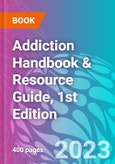The Addiction Handbook & Resource Guide offers statistics, both national and state, as well as discussions about prevention, treatment, and outcomes. It includes details on the two main types of addiction: chemical, which involves addiction to substances; and behavioral, which involves compulsive behaviors, such as gambling and gaming.
This detailed introduction to the book and to addiction specifically, written by health specialist Patricia S. Edens, PhD, RN, LFACHE, provides information on the types of addiction, recognizing symptoms, treatment options, health complications, and preventing addiction.
Section One: Studies & Statistics
This robust, colorful section of 350 pages includes detailed reports, journal articles, fact sheets, infographics, and useable materials such as vaccination cards, from a number of sources including the U.S. Department of Health & Human Services, National Institute on Drug Abuse, Centers for Disease Control and Prevention, and Substance Abuse and Mental Health Services Administration. It begins with an annotated table of contents, followed by two detailed reports on addiction and substance misuse in America. From there, articles take readers through some of the most commonly misused substances, including alcohol, marijuana, and opioids, as well as addressing current mental health considerations such as the effects of the COVID-19 pandemic.
Following this are helpful backgrounders, facts, and treatment plans about the specific conditions related to addiction that are covered in Section Three, including AIDS/HIV, Alzheimer’s disease/dementias, autoimmune diseases, cancer, cardiovascular diseases, chronic pain, depressive disorders, gastrointestinal (GI) disorders, hepatitis, impotence, infertility and pregnancy, kidney disease, liver disease, respiratory illnesses, sexually transmitted diseases (STDs), sleep disorders, and stroke.
Section Two: Addiction & Mental Health Resources
This section details a variety of resources for individuals experiencing addiction, their families, and caregivers, including agencies and associations, foundations, libraries and resource centers, research centers, support groups and hotlines, print resources, digital resources, and web sites.
Section Three: Risk Factors & Complications
This section includes 18 conditions that are considered to commonly co-occur with addiction. Overviews written by Patricia S. Edens detail the conditions themselves, how they relate to addiction, and both common and cutting-edge treatment options. Patient, family and caregiver resources follow.
Following that, users will find the following pieces of backmatter:
- Glossary of Terms lists major terms and concepts related to addiction, including terms to avoid, terms to use, and why.
- Slang Terms and Code Words presents an extensive list of common and uncommon alternate expressions to describe illicit drugs.
- Entry Index lists all director entries alphabetically.
- Geographic Index organizes listings alphabetically by state.
The Addiction Handbook & Resource Guide is a necessary reference for public and academic libraries, as well as education and health care collections, providing information crucial to individuals with addiction issues, their broader support network, caseworkers, social workers, and other education and health care providers.
Table of Contents
IntroductionSection One: Studies & StatisticsAddiction & Mental Health Resources
Samples

LOADING...








